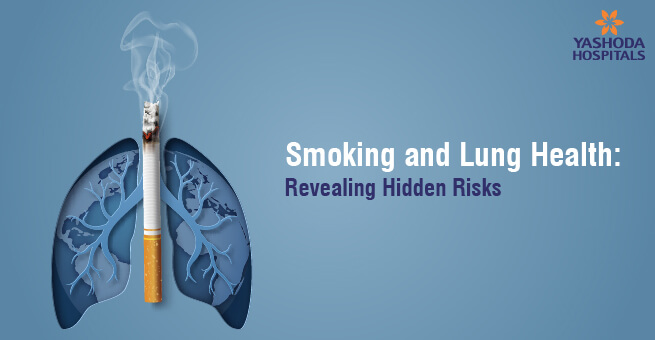

Smoking has long been recognized as a major public health concern, despite overwhelming evidence of its detrimental effects on health, affecting various organs and systems in the body. Among the most severely impacted are the lungs, crucial organs responsible for oxygenating blood and removing waste products. Let’s explore the multifaceted impact of tobacco effects on the lungs, from short-term effects to long-term consequences, and examine the potential for recovery and mitigation through lifestyle changes, contributing to the development of serious diseases.
Smoking : Smoking is a widespread habit that involves inhaling the smoke from burning tobacco, introducing harmful substances into the body. The primary culprit in tobacco smoke is nicotine, a highly addictive substance that keeps smokers hooked on this dangerous habit.
Impact of Tobacco on Lung Health
The lungs, being the primary target of inhaled smoke, bear the brunt of tobacco’s assault. Cigarette smoke contains numerous toxic chemicals, including tar and carbon monoxide, which wreak havoc on the delicate lung tissues. In particular, lungs affected by smoking experience a range of detrimental effects, contributing to various respiratory issues and increasing the risk of serious diseases.
- Tar and Toxins: When tobacco is burned, it releases a cocktail of harmful substances, including tar and toxins. These substances are inhaled deep into the lungs, coating the delicate respiratory tissues and causing damage. Over time, the accumulation of tar can lead to chronic bronchitis, characterized by inflammation and excessive mucus production in the airways.
- Chronic Obstructive Pulmonary Disease (COPD): Smoking is the primary cause of COPD, a progressive lung disease that encompasses chronic bronchitis and emphysema. Chronic bronchitis involves long-term inflammation of the bronchial tubes, while emphysema results in the destruction of the air sacs in the lungs. Together, these conditions make breathing increasingly difficult, and the damage is irreversible.
- Lung Cancer: Perhaps the most well-known consequence of smoking is the heightened risk of developing lung cancer. The carcinogens present in tobacco smoke can initiate genetic mutations in lung cells, leading to the uncontrolled growth of abnormal cells. Lung cancer is notorious for its high mortality rate, often diagnosed in advanced stages when treatment options are limited.
- Reduced Lung Function: Smoking accelerates the natural aging process of the lungs. Over time, the lungs lose their elasticity and capacity to expand and contract efficiently. This reduction in lung function contributes to shortness of breath and diminished overall respiratory performance.
- Increased Risk of Infections: The immune system in the respiratory tract is compromised by smoking, making individuals more susceptible to infections such as pneumonia and bronchitis. The impaired ability to fight off infections further exacerbates the damage already inflicted by smoking.
- Secondhand Smoke: It’s not only smokers who are at risk. Secondhand smoke, or passive smoking, can be equally harmful. Non-smokers exposed to secondhand smoke face an increased risk of respiratory infections, asthma, and other respiratory complications.
How does smoking harm tobacco-filled lungs?
- Inflammation Invasion- A triggered Storm in Your Airways: Smoking introduces harmful chemicals that irritate your lungs, sparking chronic inflammation. This constant irritation damages lung tissues, making it harder for them to function properly.
- Cilia Standstill- When Lung Cleaners Take a Break: Imagine your lungs as a bustling city, and cilia as street sweepers. Smoking, however, paralyzes these tiny hair-like structures, allowing mucus and toxins to accumulate. This leads to chronic bronchitis, marked by a persistent cough and increased mucus production.
- Alveoli Under Attack- The Price Lungs Pay for Smoking: The alveoli, responsible for oxygen exchange, face the consequences of smoking. These tiny air sacs lose elasticity, making it difficult for the lungs to expand and contract. Shortness of breath becomes a common companion.
- Oxidative Stress- When Smoking Unleashes the Free Radical Army: Smoking introduces free radicals into the lungs, causing oxidative stress. This damages cells and genetic material, increasing the risk of chronic conditions like COPD and lung cancer.
- Weakened Defenses- Smoking’s Impact on Your Lungs Immune System: Smoking weakens the immune defenses in your lungs, making you more prone to infections. Respiratory illnesses like pneumonia become more likely, and the severity of illnesses increases.
- Gasping for Breath- When Smoking Takes Your Breath Away: As smoking continues its assault on the lungs, efficient oxygen exchange becomes compromised. Airway narrowing and tissue destruction leave smokers struggling to breathe, leading to conditions like emphysema—a long-term consequence of this respiratory battle.
How Does It Affect Other Body Parts
- Heart: Smoking is a major contributor to cardiovascular diseases. The harmful chemicals in cigarettes can damage blood vessels, leading to the narrowing and hardening of arteries. This increases the risk of heart attacks, strokes, and other cardiovascular issues. Additionally, smoking raises blood pressure and heart rate, putting extra strain on the heart.
- Mouth and Throat: The impact of smoking is visible in the mouth and throat as well. Smokers are more prone to gum disease, tooth loss, and various oral cancers. The heat and chemicals in tobacco smoke irritate the delicate tissues of the mouth and throat, creating an environment conducive to the development of harmful conditions.
- Digestive System: Smoking affects the digestive system, contributing to issues such as peptic ulcers and acid reflux. It can also increase the risk of developing cancers in the esophagus and stomach. The harmful substances in cigarette smoke can interfere with the normal functioning of the digestive tract, leading to discomfort and long-term health problems.
- Skin: The effects of smoking are not limited to internal organs; they also manifest on the skin. Smoking accelerates the aging process, leading to premature wrinkles and fine lines. The reduced blood flow to the skin, coupled with exposure to harmful chemicals, contributes to a dull and unhealthy complexion.
- Reproductive System: Smoking has detrimental effects on both male and female reproductive systems. In men, it can lead to erectile dysfunction, reduced sperm count, and infertility. In women, smoking can affect fertility, increase the risk of miscarriage, and contribute to complications during pregnancy. Secondhand smoke is also harmful to pregnant women and their developing fetuses.
Smoker’s Lungs vs Normal Lungs
The stark contrast between healthy lungs and smokers lungs serves as a poignant reminder of the profound impact of smoking on respiratory health. Normal lungs, characterized by their pinkish hue and robust structure, are efficient organs designed to facilitate the exchange of oxygen and carbon dioxide, vital for sustaining life.
In contrast, a smoker’s lungs bear the brunt of prolonged exposure to tobacco smoke. The deleterious effects are evident in their appearance—discolored, inflamed, and laden with tar deposits. The toxins from cigarette smoke compromise the delicate architecture of the lungs, impairing their ability to function optimally. The cilia, tiny hair-like structures responsible for clearing mucus and debris, become paralyzed, leading to the accumulation of harmful substances.
Chronic exposure to smoke triggers inflammation and the development of chronic obstructive pulmonary disease (COPD) or emphysema, conditions that progressively diminish lung function. Additionally, the increased risk of lung cancer is a grave consequence of smoking, as carcinogens present in tobacco smoke can initiate malignant transformations in lung tissues.
While healthy lungs symbolize vitality and resilience, smokers’ lungs embody the toll that smoking exacts on the respiratory system. The visual juxtaposition serves as a compelling testament to the importance of adopting and promoting a smoke-free lifestyle for the preservation of lung health and overall well-being.
A striking comparison of a healthy lung vs. a smoker’s lung X-ray reveals the stark contrast in lung clarity and condition, highlighting the severe impact of smoking on respiratory health.
Are you aware that smoking causes irreversible lung damage, contributing to 7 million deaths annually worldwide?
Effects on 1-Year Smoker and 20-Year Smoker
The difference between a 1-year smoker and a 20-year smoker is not only measured in the duration of tobacco exposure but also in the extent of health consequences and risks associated with long-term tobacco use. Many people wonder, “Can lungs heal after 20 years of smoking?” The answer is encouraging—while the process may take time, the body can heal itself, and positive changes can occur in the lungs after quitting smoking.
1-Year Smoker Lungs:
- Early Stage Impact: A 1-year smoker is likely to experience early-stage effects of smoking. These may include a mild decline in lung function, increased respiratory mucus production, and a potential decrease in physical endurance.
- Limited Damage: While the short-term impact may be noticeable, the overall damage to the lungs and other organs is comparatively limited at this stage.
- Reversibility: Some of the early effects on lung health may be reversible if the individual quits smoking promptly. The body has a remarkable ability to heal, and in the early stages, quitting smoking can lead to improvements in lung function and overall health.
20-Year Smoker Lungs:
- Advanced Health Risks: A 20-year smoker faces a significantly higher risk of severe health complications. Prolonged exposure to the toxic substances in cigarette smoke greatly increases the likelihood of developing chronic conditions such as chronic obstructive pulmonary disease (COPD), emphysema, and lung cancer.
- Irreversible Damage: The cumulative damage to the lungs and other organs over two decades is often irreversible. Chronic inflammation, reduced lung capacity, and impaired overall respiratory function become more pronounced.
- Increased Health Risks: Long-term smokers not only face heightened risks of respiratory issues but also an elevated risk of cardiovascular diseases, various cancers, and other systemic health problems.
How to recover lungs from smoking by following these tips
- Quit Smoking: This is the cornerstone of lung recovery. Immediate benefits start to emerge once you cease smoking, and over time, the healing process continues.
- Stay Hydrated: Drinking plenty of water helps keep the mucous membranes in your lungs moist, facilitating the removal of toxins and reducing respiratory irritation.
- Exercise Regularly, Including Running: Smoking and running may seem incompatible, but enhancing your ability to engage in physical activities can improve lung function and capacity. Aerobic exercises strengthen respiratory muscles, contributing to increased lung efficiency.
- Deep Breathing Exercises: Incorporate techniques like diaphragmatic breathing and pursed-lip breathing to enhance lung capacity and efficiency.
- Eat a Healthy Diet: Consume a diet rich in fruits, vegetables, and whole grains to provide essential nutrients that support overall health, including lung health.
- Avoid Environmental Toxins: Minimize exposure to secondhand smoke, air pollution, and occupational hazards. Consider using air purifiers in indoor spaces.
- Consider Supplements: Some studies suggest that certain vitamins and minerals, such as vitamin C, vitamin E, and omega-3 fatty acids, may support lung health. Consult with a healthcare professional before taking supplements.
- Get Regular Check-ups: Schedule regular check-ups with your healthcare provider for lung function tests and monitoring. This proactive approach can help identify any issues early on.
The Recovery Journey:
- Early Stages of Recovery: The positive effects of quitting smoking begin almost immediately. Within the first few days, lung function starts to improve, and the body initiates the process of repairing damaged tissues. Cilia, essential for clearing mucus and preventing infections, start to recover.
- Intermediate Recovery: Over the weeks and months following smoking cessation, respiratory symptoms, such as coughing and shortness of breath, often diminish. The risk of respiratory infections decreases, and the lungs continue to repair and regenerate.
- Long-Term Recovery: Lung health continues to improve over the years after quitting smoking. The risk of developing smoking-related diseases, including COPD and lung cancer, decreases substantially. However, some long-term effects may persist, highlighting the importance of sustained efforts to support lung health.
Remember, recovery from smoking-related damage is a gradual process, and individual results may vary. If you have concerns about your lung health, seek guidance from a healthcare professional for personalized advice tailored to your specific situation.
The impact of smoking on lung health is profound and far-reaching. Understanding the consequences, regardless of the duration of smoking, emphasizes the urgency of quitting. By making lifestyle changes, seeking support, and adopting preventive measures, individuals can take control of their lung health and pave the way for a longer, healthier life. It’s never too late to quit smoking and unmask the hidden dangers that threaten our most essential respiratory organs.
References:
- Tobacco and its effects on lungs: https://www.cdc.gov/tobacco/data_statistics/fact_sheets/health_effects/effects_cig_smoking/index.htm
- Impact of smoking on Lungs https://www.betterhealth.vic.gov.au/health/healthyliving/smoking-effects-on-your-body
- Smoker’s Lungs vs Normal Lungs https://www.medicalnewstoday.com/articles/smokers-lungs-vs-healthy-lungs
- Effects on 1-Year Smoker and 20-Year Smoker: https://www.healthline.com/health/smoker-lung-vs-healthy-lung
- Preventive Tips https://www.mdanderson.org/cancerwise/what-happens-to-your-lungs-from-smoking–3-things-to-know.
- How to Get Back Healthy Lungs After Smoking https://precisionmedical.com/how-to-get-back-healthy-lungs-after-smoking/
About Author –
Dr. Gopi Krishna Yedlapati, Consultant interventional pulmonologist, Yashoda Hospital, Hyderabad
MD, FCCP, FAPSR (Pulmonology)
About Author
Recent Posts
రక్తదానం: అర్హులు, ప్రయోజనాలు మరియు అపోహల గురించి సంక్షిప్త సమాచారం
మనిషి బ్రతకడానికి ప్రాణవాయువు ఆక్సిజన్ ఎంత అవసరమో రక్తం కూడా అంతే అవసరం. రక్తం, శరీరంలోని ప్రతి కణంతో అనుక్షణం…
నరాల సంబంధిత వ్యాధుల రకాలు, కారణాలు, లక్షణాలు & నిర్ధారణ పరీక్షలు
నరాల సంబంధిత రుగ్మతలు అంటే నాడీ వ్యవస్థ మొత్తం మీద ప్రభావం చూపే వ్యాధులు. నాడీ సంబంధిత పరిస్థితులు ఇప్పుడు…
Endovascular Surgery: Minimally Invasive Solution to Vascular Disease
Endovascular surgery is a revolutionary advancement in medical technology wherein doctors can treat almost any…
పల్మోనరీ ఎంబోలిజం: లక్షణాలు, కారణాలు మరియు చికిత్స విధానాలు
పల్మోనరీ ఎంబోలిజం అనేది చికిత్స మీద ఆధారపడిన ఒక తీవ్రమైన పరిస్థితి, ఇది సాధారణంగా ఊపిరితిత్తులకు ప్రయాణించే రక్తంలో గడ్డకట్టడం…
Rhinoplasty: Understanding the Nose Surgery Procedure and Its Benefits
Rhinoplasty is commonly known as a nose job that is usually designed to reshape a…
Is Spine Surgery Safe? Exploring Minimally Invasive Techniques and Recovery
Spine surgery is a source of fear for most people, yet it has undergone significant…

